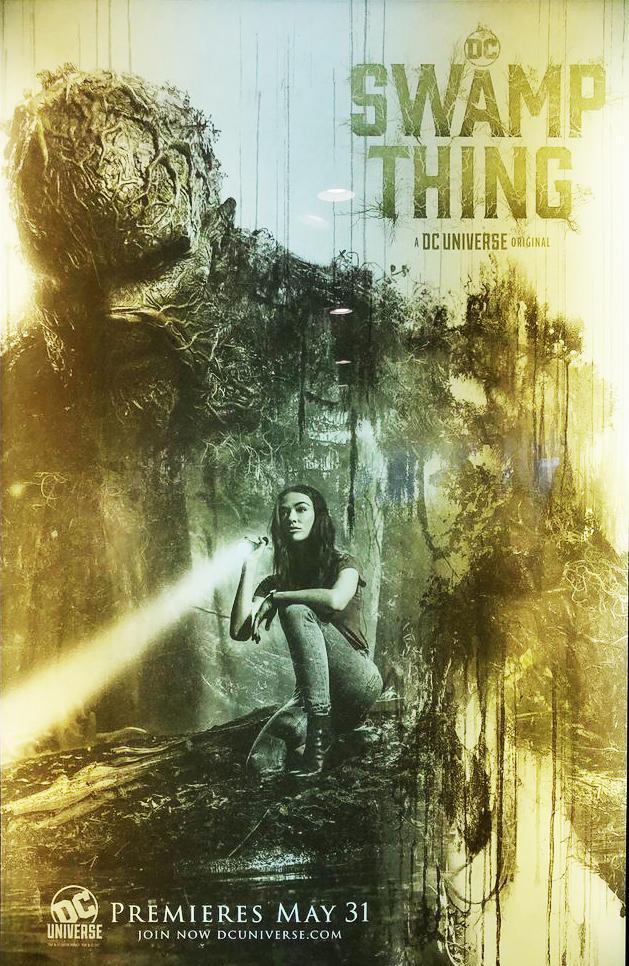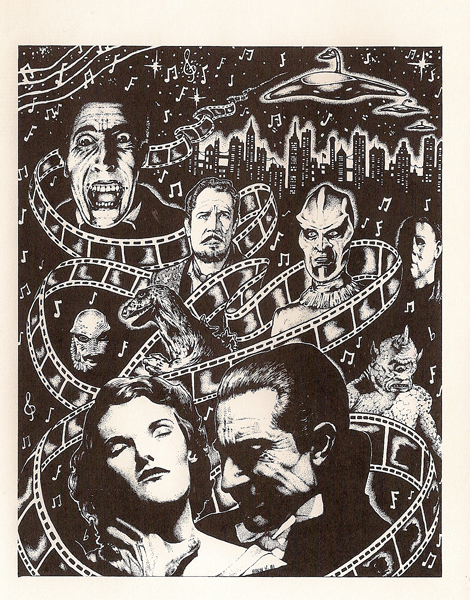July 27, 2019
Brian Tyler: The Sonic Bayou Music of SWAMP THING
Interview by Randall D. Larson


Brian Tyler is known for his work on many of the FAST & FURIOUS films (2006+ #s 3, 5, 7+), RAMBO (2008), THE EXPENDABLES franchise (2010-2014), IRON MAN 3 (2013), AVENGERS: AGE OF ULTRON (2015), CRAZY RICH ASIANS (2018), television’s HAWAII FIVE-0 (2010-19), SLEEPY HOLLOW (2013-17), YELLOWSTONE (2018+), and many more. Tyler attended Harvard University for graduate school and UCLA for undergraduate school. Among his first film scores were SIX-STRING SAMURAI (1998), TERROR TRACT (2000), FOUR DOGS PLAYING POKER (2000), with his 2001 score for the late Bill Paxton’s FRAILTY giving him some positive recognition, including a nomination for “Discovery of the Year” at the 2002 World Soundtrack Awards. Tyler was nominated for Film Composer of the Year in 2009 by the International Film Music Critics Association and ranked as one of the top film composers of 2009 by Film Score Monthly. By the 2010s Tyler had reached high ranks of Hollywood film composers, consistently scoring major films and later in the decade embarking on worldwide concert tours, conducting his film music for huge audiences. In addition to his film compositions, Tyler also writes and performs under his artist name Madsonik. In 2012, Tyler arranged a new version of the Universal Pictures fanfare, originally composed by Jerry Goldsmith, recorded for the studio’s 100th anniversary. In 2018, he was hired by Formula One to write a brand new theme that was released on March 23. Tyler’s most recent television work was for the DC Universe series, SWAMP THING (2019), which we’ve discussed at length in the interview that follows. -rdl
Q: The Swamp Thing character has always been an unusual heroic concept. What was your initial take on how it should be scored?
Brian Tyler: The idea that someone can be a hero and be the cause of good in spite of being relegated to monster status is a great set-up. We’ve seen similar kinds of heroes to an extent—where you’re talking about Batman there’s that thread of the superhero who doesn’t get credit, where they’re pursued, but in this case just the physical presence of the Swamp Thing looks so monstrous to everyone that there’s a knee-jerk reaction against him. There’s also the idea of the classic storyline of the cursed protagonist. So you have music that can convey the awe as well as the darkness, danger, and scariness of the scenario but at the same time have a feel that is heroic and emotionally human, where we really feel for this character.
Q: What kind of orchestral palette did you use on this?
Brian Tyler: A traditional orchestra, mainly brass, strings, and some woods, but I did the percussion and some stringed instruments here at my studio, mainly by taking apart different instruments that felt “of the swamp.” There’s definitely a Southern feel to them, various stringed instruments and dobros and things like that. The percussion was a little more swampy in effect than classical. That gave it a unique flavor that fit the setting and the story concept. I wanted to ground this score in a sense of place, so the feel of it has a bayou/Cajun sensibility, and when you combine it with the hyper-extended orchestra, where I’ve added contrabass trombones, which are so low and weird, and then contrabassoon and these very, very low instruments. I thought it felt very Swamp Thingy!

Q: I love those low tones; they really create a mutable vibe, like thick, murky swamp water intersected by the tendrils of these strange plants…
Brian Tyler: Yeah! I wanted a very natural atmosphere beneath all the score, because the Swamp Thing obviously has this connection with nature and can manipulate roots and branches and things like that. So the vast majority of music is organic, and that allows for certain instruments that you wouldn’t normally find in a superhero score, like dobros and slides, and hand percussion. At the same time the orchestra gives you this epic scope, like this is still a superhero story, but it’s got a twist on it. There’s a lot more room for that down and dirty kind of instrumentation that is not slick enough for a storyline that would take place in Metropolis or Gotham City.
Q: Is there also an electronic component to the score?
Brian Tyler: There is, but it’s just that the electronic components come through the back door, through analog means. These are the electronics that run through amplifiers and guitar pedals and things like that, to make them feel dirty. We use little amps that were really harshly overdriven, instead of gigantic amps. I got the idea when I was down in New Orleans and I’d see street performers and they would use these little portable pig-nosed amps. For SWAMP THING I would crank them way too loud for what they’re really meant for, but that allowed them to distort and make a grungy sound. A lot of the sounds were done that way; there’s nothing really very clean in the recordings—there’s a lot of sonic residue on them!

Q: What kind of thematic structure have you given the characters in this series?
Brian Tyler: With Abby Arcane there’s a main theme but there’s also a sub-theme, depending on the tone of what’s going on in a given scene. There are two main key components to her: one is this more sensitive motif which is connected to her emotional struggle with what’s happening in Marais, where her humanity comes through. Then we have her in active mode, where she’s investigating and figuring things out; those two are separate things but they can be done in close proximity to each other, but they just can’t be layered on top of one another so much. Swamp Thing also has two modes. He has this melodic, longer-lined music for his emotional, human element, but there are also these singular motifs from descending brass that are used when he is in monster mode—when he’s protecting someone or going after the baddies and all that. I found almost everything had two sides to it—even when you’re talking about the politician businessman Sunderland or the townsfolk or even the different regional areas within the story. In the pilot we also had Alec Holland’s lab: is it creepy? Is it dangerous? Is he helping people? So, to keep things tonally clear we really needed two separate themes for everything.
Q: There are a variety of sub-plots and different character interactions going on below the overarching storyline. It seems like a fascinating opportunity to treat all of these things musically while keeping them integrated within the overall vibe of the bayou setting.
Brian Tyler: Exactly. It’s right in the title, “SWAMP THING.” The swamp is a character, and everyone had to connect to that in one way or another. Doing a Marvel movie or something like that you’re scoring more of a globetrotting story: you’re going to New York, then you’re in Wakanda, and then you’re in South Korea or Asgard or out in space. This show needed to keep the themes a little more closely related because the setting is more confined. It’s a bit trickier to do, and that goes for leitmotifs and for character themes as well, they all have this connection—but at the same time point out the tonal differences of what different characters are up to. Some characters switch connections and there are twists—you need to set up a character to feel a certain way but then when the twist happens and they may switch from the good side to the bad side, or vice versa, the music needs to make that transition but still retain that character’s theme in a recognizable way.

Q: Like Kevin Durand’s scientist character, Jason Woodrue, who comes in to do the work for Sunderland. Is he good? Is he bad? Yes and no; he shifts.
Brian Tyler: Right, and he comes in there and he’s definitely a fish out of water at first, and he confronts Sunderland, and it’s like what’s going on here? There’s also a bit of an eco-story in there about us creating toxic scenarios that have unexpected outcomes, and that certainly goes into it as well, with those characters in particular.
Q: Then there’s the character of the child, Suzi, and her connection to Swamp Thing.
Brian Tyler: She is your classic innocent character who gets put in the middle of everything. Her body is failing her because of what has happened to her; her connection to Swamp Thing really illustrates very quickly what his character is all about, a protector of the innocent. In that way I think it was a great opportunity to do something that had a lot of humanity, and in fact her thematic material is actually a flip on the Swamp Thing theme, which you wouldn’t really recognize at first as it begins right in the first episode. We needed to introduce her thematic material before Swamp Thing even existed in the story.
Q: Now you’re working on or have finished another movie with YELLOWSTONE’s Taylor Sheridan, THOSE WHO WISH ME DEAD, which is a Brian Tyler Western, which sounds pretty exciting.
Brian Tyler: Yeah, it’s awesome! THOSE WHO WISH ME DEAD is fantastic and Taylor is an amazing director. Then there’s CHARLIES ANGELS, and Elizabeth Banks is also great as the director in that, and I’ve so enjoyed scoring it. I just recorded RAMBO three days ago, and that’s incredible too. It really gave me a chance to thematically get to the crux of who Rambo is, and I feel it has the most to say of that franchise. So all three of those have been great experiences. And FAST 9’s coming up soon!
For more details on Bryan Tyler see his website
Special thanks to Steph Bryant at Brian Tyler Inc. for her assistance in facilitating this interview.
Swamp Thing logo and title card © Warner Bros Television Distribution.
Watch the SWAMP THING trailer from DC Universe




